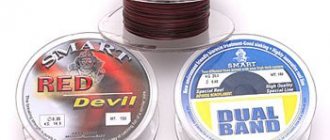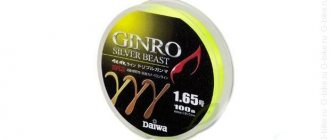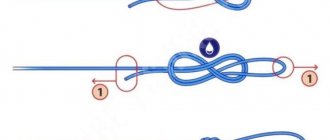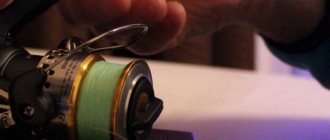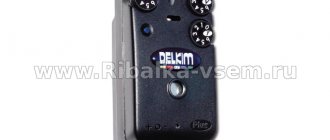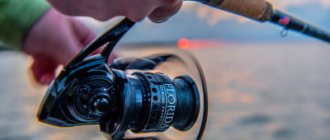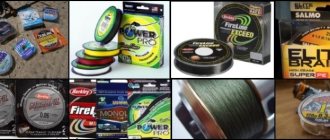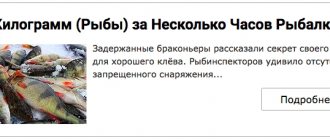It is not uncommon for a fish to win a fishing fight by escaping the fisherman and ruining his hunting weapon. A retaliatory strike cannot be avoided; the fisherman, with all responsibility and the desire to take revenge, prepares for a new battle, selects tackle and other elements of equipment. The correct choice of fishing line will determine the success of this fight.
What this part of the equipment is, what material it is made of, what types there are, how to choose the right fishing line, what secrets and methods of storing it exist, what fishing knots can be tied and how to do it - you will learn from this article.
Content
- 1. General description
- 2. What is monofilament line made of?
- 2.1 MonoFilament
- 2.2 Copolymer
- 2.3 High-copolymer
- 2.4 Fluorocarbon
- 3.1 Drowning
- 3.2 Conditionally drowning
- 3.3 Fluorocarbon balanced monofilament lines
- 3.4 Fluorocarbon floats
- 4.1 Diameter
- 4.2 Load
- 4.3 Stiffness
- 4.4 Stretching
- 4.5 Memory
- 4.6 Interaction with water
general description
Fishing line is a thread or cord that serves as the basis for fishing tackle, with the help of which the elements of equipment are connected together.
The purpose of the fishing line is to allow you to cast bait with bait, hook and fish out prey.
Standards, requirements and other characteristics for this element of equipment are established by IGFA - International Game Fishing Association or the International Sports Fishing Association, which you can read about on this website https://www.igfa.org/
Monofilament fishing line is a fishing thread that has a round cross-section and is made from artificial materials, which will be discussed below.
“Mono” means “one” (single) from Greek, that is, the fishing line consists of one thread.
Other names for monofilament line used by fishermen:
- monofil;
- monofilament;
- monofilament.
What is monofilament line made of?
The modern fishing market presents 4 types of material for making monofilament lines:
- monofilament or monofilament ;
- copolymer or copolymer ;
- high-polymer or high-copolymer ;
- fluorocarbon or fluorocarbon .
Their distinctive feature is the material and manufacturing method. Each type is not ideal; there are both pros and cons, which will be discussed below.
2.1 MonoFilament
This type of fishing line is made by extrusion from polyamide (traditional nylon), when soft and molten material is pushed through a special hole in the extruder (process equipment).
You can read more about the technical process of “extrusion” here https://ru.wikipedia.org/
Advantages of monofilament lines:
- fit well on the reel, making it easier to cast the bait;
- tolerate temperature changes well;
- have sufficient transparency;
- good stretch and strength;
- a certain resistance at the node;
- good shock absorption when fishing for prey, which relieves the load on the reel mechanisms.
Disadvantages of monofilament lines:
- dry out (age) due to natural influences;
- limited shelf life;
- low rigidity;
- high cost.
What to use with:
- with spinners (rotating);
- with low-density baits, for example, wobblers.
A short video about the production of this thread
2.2 Copolymer
The fishing line is made from several types of materials using special technologies aimed at improving the external properties of the thread in order to achieve strength and quality when catching various types of fish. Unlike the above type, this fishing line is more rigid.
Area of application : jig fishing with a spinning rod.
Advantages of copolymer lines:
- do not get confused, due to this property, hooking is easy;
- more rigid, the jerks (bites) of the fish are better felt;
- elastic enough to absorb the jerks of production;
- durable;
- wear-resistant.
Disadvantages of copolymer lines:
- high cost.
- less tensile strength than nylon fishing lines.
2.3 High-copolymer
When producing this type of fishing line, the manufacturer used even more complex technology and materials.
Advantages of high-polymer fishing lines:
- high strength;
- quality that allows you to use such a fishing line in different weather conditions and fishing;
- good “friendship” with water;
- fast-sinking;
- performs well when exposed to sunlight and frost;
Disadvantages of high-polymer fishing lines:
- high cost.
2.4 Fluorocarbon
The fishing line is made of polymer (polyvinylidene fluoride or PVDF).
Advantages of fluorocarbon:
- not visible in water.
- when in water, it does not absorb moisture, which allows it to retain its original characteristics (section, strength) for a long time;
- tolerates exposure to hot and cold temperatures (from – 40 degrees to + 160)
- Due to its hard top layer of material, it is resistant to abrasion.
Disadvantages of fluorocarbon fishing line:
- high cost;
- in comparison with other fishing lines, it has the lowest breaking load compared to other types of monofilament;
- excessively hard;
- not strong knots, since when it gets into water it does not swell and the knot is not strong because of this, so many people use glue to secure the knot, which causes additional trouble, and the installation of the knot must be done carefully so as not to tear the fishing line.
Application area:
- as a leash;
- less often as the main line for spinning fishing;
- Popular among pole fishermen.
Attention! On the fishing market there are fishing lines from manufacturers who, in order to reduce the cost of their goods, produce nylon fishing lines coated with fluorocarbon. The packaging says “fluorocarbon coated”.
You can read more about the properties of fluorocarbon fishing line on the page https://fishing.zp.ua/poplavochnaya-lovlya/flyurokarbon-protiv-obychnoj-leski
Types of fishing line for spinning
Companies specializing in the production of products for fishermen are constantly offering new products with improved characteristics. Understanding what is really suitable is not easy, especially for a novice amateur fisherman. When fishing, for example, with a spinning rod, three types of fishing line are used today.
Wicker
This thin cord, consisting of several strands, the raw materials for which are high-tech polymers, is often used as tackle. Naturally, this method of producing fishing line makes it possible to obtain a product with a high breaking load.
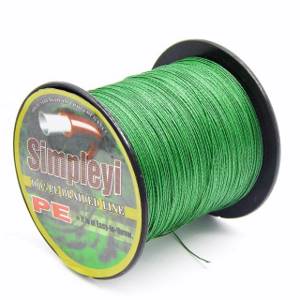
Braided fishing line for spinning
pros
- excellent strength;
- zero stretch;
- softness and lightness;
- high service life;
- ease of use and storage;
- variety of shades;
- no memory effect;
- resistance to ultraviolet radiation.
Minuses
- demands on the quality of the coil;
- the ability of fibers to fray when in contact with snags and stones;
- due to the lack of stretchability, there is a high risk of the spinning rod breaking when pulling out large fish;
- deterioration in performance due to stagnation of water between the fibers;
- poor frost resistance;
- high price.
In addition, there are no transparent cords. And the braided line, visible to predatory fish, can scare them.
It is recommended to use such a fishing line in cases where there is a high probability of snagging.
Fluorocarbon
This type of product appeared not so long ago, but has already become popular among fishermen. Line is produced from polyvinylidene fluoride by melting granules and squeezing the mass through dies of a certain diameter. The birthplace of the invention is Japan, which today occupies a leading position in the production of these products. Fluorocarbon is most often used as a material for leashes, but many fishing enthusiasts also use it as a base.
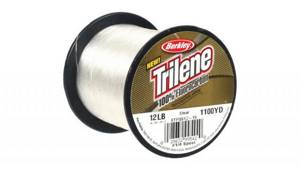
Fluorocarbon line
pros
- resistance to temperature influences;
- non-exposure to ultraviolet radiation and aggressive environments;
- resistance to drying out, wear and deformation;
- no memory effect;
- long service life;
- sufficient rigidity to ensure good bite transmission to the rod;
- high degree of transparency, ensuring the invisibility of the fishing line.
Minuses
- insufficient tensile strength;
- high ductility, leading to gradual weakening of nodes:
- high cost of branded products.
Monofilament
This type of fishing line is one of the most common and popular options. Nylon is used to produce equipment.
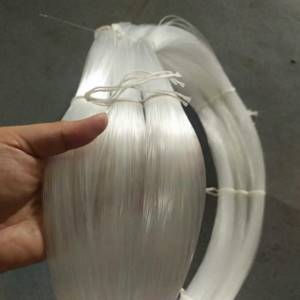
Photo of monofilament fishing line
pros
- small jq friction coefficient;
- smoothness, ensuring good sliding along the rings;
- stretchability, which allows you to smooth out the jerks of the caught fish;
- transparency, which provides good camouflage;
- budget cost.
Minuses
- less strength compared to a wicker counterpart;
- high tangles;
- loss of performance properties over time, which imposes a limitation on the service life;
- insufficient resistance to sunlight;
- the presence of a memory effect;
- poor sensitivity when fishing at long distances.
Video - About the features of different types of fishing lines
Classification of fishing line by physical properties
Monofilament fishing lines are:
- drowning;
- conditionally drowning;
- fluorocarbon balanced;
- fluorocarbon floating.
3.1 Sinking monofilaments
They sink on their own due to their water absorption properties. This is a new generation fishing line of the fluorocarbon type. Due to the peculiarity of absorption, the fishing line remains strong and does not lose its properties.
Interestingly, there is a method for turning an ordinary fishing line into a sinking one. To do this, the surface of the fishing line is treated with a special solution “sinkant”.
3.2 Conditionally sinking monofilament lines
This type of monofilament includes most fishing lines used on match rods when fishing for carp. The peculiarity of the thread is that it does not sink on its own; it must be drowned using a weight and the tip of the tackle.
3.3 Fluorocarbon balanced monofilament lines
Such monofilaments are used with special baits and when fishing in a specific layer of water. They have not found their application on the Russian market.
3.4 Fluorocarbon floats
This type is the most common and includes all those fishing lines that anglers use for all types of fishing.
Parameters of monofilament line
4.1 Diameter
Why should you pay attention to this characteristic? Firstly, different types of fishing use different fishing line diameters. This parameter will affect the distance of the bait being thrown. For example, when using a thin line, the bait will be cast further, but the small diameter will facilitate its drift by the wind. Secondly, it also affects the size of the fish; the thinner it is, the smaller the prey, otherwise the fishing line will break. Thirdly, the smaller the diameter, the more invisible the line is to the fish in the water. Fourthly , thin fishing line wears out quickly.
Diameter (thickness or cross-section) is measured in millimeters.
Table for determining the diameter of the fishing line by the number on the package
4.2 Load
The load of the fishing line is related to its thickness (diameter). This parameter is reflected on the package in kg; the most common line diameter is from 0.06 to 1 mm.
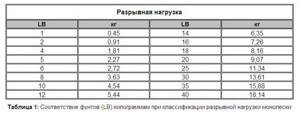
4.3 Stiffness
Rigidity affects the strength of the line in the area of knots. Also, such lines come off the reel worse, and soft lines tend to twist and get tangled, so each angler decides for himself which line to use.
You should know:
- All monofilament lines are twisted.
- if monofilament is used as a leader, then the less rigid line will twist faster under the influence of the nozzle or the reel fraction in a strong current and the leader will stretch and become unusable.
Thus, a rigid line:
- Sturdy but in knot-free condition.
- Doesn't get confused.
- Does not stretch and easily returns to its original form.
- It practically does not absorb water and does not lose its chemical properties.
- It has a memory, which affects the coming off the spool and its passage through the rings of the gear and, accordingly, makes it difficult to make a long cast.
- High cutting speed, which is good.
Soft line:
- Less durable.
- Confused.
- It stretches and does not return to its original position.
- Absorbs water.
- Holds knots very well.
- Elastic.
4.4 Stretching
This characteristic indicates the ability of the fishing line to stretch under the influence of equipment elements and return to its original position. All monofilament lines have a high stretch coefficient. This is both bad and good.
Pros:
- shock absorption when biting large fish, especially when using flexible gear, which will allow you to catch a large trophy on a thin line.
Minuses:
- severe wear of the fishing line;
- excessive stretching will allow an increase in bait breakages, since there is no control over stretching, but there is a limit;
- affects the landing of fish to the shore, due to the fact that the fishing line does not drag it, but only stretches.
You should know that the smaller the diameter, the greater the stretch.
An interesting video experiment from the author of marikfionhttps about the effect of monofilament stretchability on hooking
4.5 Memory
Line memory is the inability of the line to regain its previous position, which affects casting and unwinding of the thread from the reel. One of the negative properties of monofilament.
Shimano, Daiwa, etc. produce monofilament fishing lines with the smallest memory.
4.6 Interaction with water
In this regard, monofilaments have an advantage over braided lines, but not over fluorocarbon. Mono fishing lines are known to absorb water. Some models are a little larger, some smaller. When water is absorbed, the fishing line swells and becomes noticeable in the water; with prolonged fishing, it also becomes less durable.
Advice:
- Before you wind such a fishing line onto a reel, you need to dry it, since having absorbed water, it also stretches more.
Rating of fishing lines
Owning a large assortment of fishing thread, the demand market for the most popular materials classifies them not only according to the material of manufacture - nylon, nylon, fluorocarbon.
A rating of manufacturers that produce materials of high quality and ideal technical characteristics will help you choose the best core option:
- The top 10 rating is opened by threads from Varivas Super Trout. New generation VLS nylon threads hold knots well and are well suited for float fishing.
- Shimano BlueWing is a leader in production and sales. One of the best budget options.
- Benkei is a modern version of the latest generation, high strength, resistance and cost.
- Soft is a combination of three types of polymers. Ideal for spinning rods and Bolognese fishing rods.
- Balsax Iguana is the most common variant with a bearded past. The cost is high, but it's worth it.
- Tarantula is a monofilament with a high test load. Suitable for large trophies.
- ShimanoTechnium Spinning Line - invisible in the water, has a good base and high sensitivity.
- Shimano Antares Fluorocarbon is the most durable, there is no stretch or memory effect.
- Hi-Max Fluorocarbon - fluorocarbon material gives the fishing line rigidity, and the green color helps it hide in vegetation.
- Kameleon is a type of vein that changes color depending on the conditions of the reservoir. High level of wear resistance.
Fishing success depends on the choice of fishing line. Casting, leashes, baits, hooking are impossible without this element of gear. Synthetic material has achieved great heights and results. Analyzing the product rating, we can say with certainty that the victory belongs to Japanese manufacturers.
Advantages and disadvantages of monofilament fishing line
Advantages of monofilament fishing line:
- The line glides well along the guide rings of the gear, which allows for high-quality long-distance casting of lighter baits.
- Casting heavy baits will be much further if you use monofilament in conjunction with braided cord.
- It performs well in water due to its low resistance to water, which ensures the effectiveness of bait fishing at different depths, which, with high-speed fishing, will not push the bait onto the water surface.
- Compared to braided line, it behaves quietly in the water, which does not scare away the fish.
- Thanks to its good elongation, with the simplest inertial reel installed, monofilament does a good job of absorbing sharp jerks when playing fish, which reduces the load on the rod.
- Allows you to use a simple rod and an inexpensive reel.
- It has different cross-sectional shapes: round, oval, square, hexagonal.
- Wide color range, which allows you to choose fishing line taking into account specific location and conditions.
- Affordable price.
Disadvantages of monofilament fishing line:
- May not be applicable with all types of gear.
- Not all fish species are suitable for fishing with monofilament line.
- It tends to absorb water, which causes the material to swell and the fishing line becomes weak and durable.
- After stretching it does not recover.
A short video (by Pavelcynarev) about the disadvantages and advantages of monofilament
Specifications
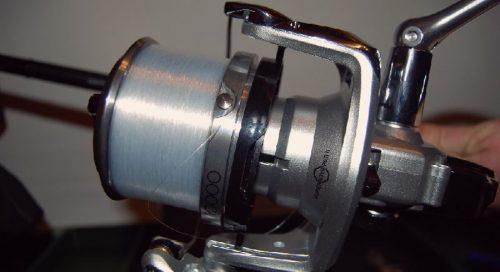
Making a core is a step-by-step process. The basis of the raw material for the product consists of very small nylon balls. Exposed to high temperatures, the raw material is passed through holes of the required diameter. The resulting wires are carefully moved along special roller devices, stretched and undergo a cooling procedure.
An important stage in completing production is the stage of impregnation of the fishing line with a waterproof substance, which gives it strength and increases its service life.
For the average fishing enthusiast, monofilament fishing line remains interesting and in demand.
The main characteristics of the core are:
- good stretchability, it is necessary for the extraction of large specimens, but at the same time the service life is lost. A thread with a large diameter may not always have a high load rate;
- the breaking load coefficient indicates the ability of the fishing line to maintain the resistance of prey, in this case, a thin fishing line with a high strength index always wins;
- different calibration is an indicator of casting distance. One thing is clear - the thinner the thread, the further it is thrown, but it can be blown away by the wind. The quality of calibration depends on the manufacturer. A calibrated core always has a uniform diameter. The rounder the diameter, the higher the class and quality of the fishing line;
- resistance to temperature changes, this indicator is exactly the same as monofilament, it is universal. Its use is effective during winter fishing; water does not freeze on it;
- ideal transparency of the vein increases the chances of getting the desired prey.
Modern branded manufacturers use not only high-tech equipment in the production of monofilament, but also the best coatings with a high level of polymerization.
One thing is clear: the more expensive the manufacturing technology, the higher the cost of the product.
Among the negative reviews from fishermen about the vein is that:
- The use of monofilament is not suitable for all types of fish; some specimens are better caught on colored cords;
- absorbing water, it swells and loses its strength, which means its service life decreases;
- the fishing line is not able to recover to its previous state after stretching - a bad option for fishing.
For good and long-term service, monofilament requires proper storage. The influence of external factors gradually leads to its unsuitability. An excellent place to store the core is in the refrigerator. There is no influence of ultraviolet radiation and high temperatures.
Line is used in many fishing methods and is considered one of the important elements of equipment. Neither summer nor winter fishing can do without it. They are equipped with a monofilament when fishing with bottom, float rods and ultralight spinning rods.
How to choose monofilament fishing line
Basic requirements for fishing line:
- strength;
- elasticity;
- stealth in water;
- resistance to natural influences;
- resistance to friction.
Recommendations:
- Study the packaging, which indicates the manufacturer, fishing line parameters, storage methods and all markings.
- It is best to purchase fishing line not from spools, but to wind it on your own spool, since it is not possible to establish with what equipment it was wound, by whom, where, etc.
- Pay attention to appearance. The new line looks shiny. The old fishing line is faded and has a matte tint due to cracks in the top layer.
- The diameter of the fishing line must be the same along its entire length. It is checked this way: you clamp the weight and move it along the fishing line, and where this parameter has changed, the weight either will not pass or will slip. A fishing line with an equal diameter along its entire length is called “calibrated”. If the fishing line is not calibrated, then for strength you should take a fishing line with a larger diameter.
- Check the breaking force by hanging a load with a weight equal to the maximum allowable, indicated on the manufacturers’ packaging. You can also check using a dynamometer.
- When unwinding the reel, pass the fishing line between your fingers; if it goes smoothly, then it has no memory, it will not spin and will lie flat on the bottom.
- When choosing, you need to take into account transparency, since this characteristic will work well when catching shy (cautious) fish.
- The characteristics of the reservoir should also be taken into account: vegetation, water turbidity, etc., and the equipment used.
You should know that the quality of this equipment element affects:
- for casting distance;
- for casting accuracy;
- correct delivery of bait (attachment);
- success of cutting;
- safety of the equipment used.
A short video from the “Men’s Company” channel about choosing monofilament fishing line for spinning tackle
Types of material for manufacturing
The latest core manufacturing technologies use chemical raw materials, which give it exactly those qualities that cords do not have. With such a pace of quality improvement, monofilament fishing line is becoming more popular and in demand among fishing enthusiasts.
The most common materials for making fishing line are polyamide derivatives:
- High-copolymer types are characterized by the most modern chemical compounds and have a complex manufacturing process, thanks to which the quality of the thread is the highest and the service life is the longest. The high type of polymer gives the fishing line resistance to ultraviolet rays, increases the smoothness of the product and resistance to destructive external factors.
- Copolymer threads are made by combining several types of polymer materials. This combination gives the material new features - strength, durability, rigidity and minimal stretchability.
- Monofilament types are manufactured using an extrusion process, when a soft, elastic and stretchable core is obtained from a viscous mass. Transparency, density and resistance to temperature changes make this species in demand by fishermen. Unfortunately, they have a short service life, gradually wear out and become unusable.
- Fluorocarbon fishing threads are made from chemical polymers that are highly resistant to negative physical and chemical factors - temperature changes, ultraviolet radiation, mechanical stress, and getting wet. What is fluorocarbon - the material from which modern cores are made with many advantages, but at a high cost.
Choosing a fishing thread is not as simple as it seems, and each angler will determine which one is best for himself individually. This process requires clarity on where to fish, in what method and what kind of prey, what class of spinning rod, what type of bait. It is important to take into account temperature indicators, currents, bottom topography and the presence of vegetation.
Much of fishing depends on the quality of the line and its ability to be strong, buoyant, invisible and resistant to damage. Whether it's fluorocarbon, nylon or copolymers, the choice is always up to the fishing enthusiast.
Types of knots for monofilament fishing line
Stopper nodes:
- “ Duncan ” is a locking unit used for mounting a sliding float. When tying a knot, you should take into account the moment of free sliding of the float, and also avoid deforming the knot.
- «Bloody locked».
- «Bloody tucked».
- “Marshall trap” - the tip of the fishing line and the main part are tied together with a regular knot, so that a loop is formed. Then the loop needs to be inserted into the eye of the hook. It is put on the forend and the end of the fishing line is passed through. Next, you need to pull out the shorter tail and tie a very ordinary knot. Take a long ponytail and stretch it. In this case, the knot moves towards the hook. Trim off the excess tails and the knot is ready.
- «World fair"or node world Fair Knot fits like this
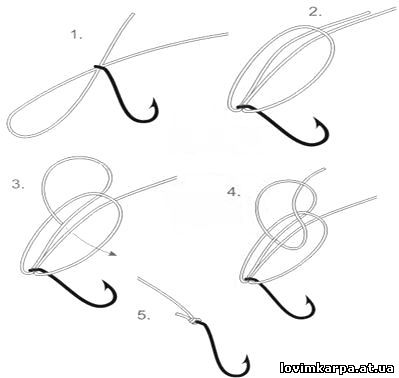
- About the method of tying a knot "Grinner»
- Node "Pitzen" looks like that


A short video about the method of tying a bloody knot from FishingVideoUkraine
Here's another educational video
You can read about other types of knots for monofilament fishing line here https://fishingclub-zt.ucoz.ua/load/uzly_dlja_monofilnykh_lesok/12-1-0-83
Operation and storage
Over time, the threads age and lose strength. The cause of this condition is considered to be exposure to sunlight or storage near radiators of the heating system.
They should be stored in a dry and dark place, preferably in the refrigerator, where stable temperature and humidity will do their job, and also:
- good ventilation for the core is to rewind it onto another spool, so the product wears out evenly;
- monofilament loses strength if it is dried after fishing in the sun;
- It is better to dry the thread in the shade;
- Treatment of the thread with pharmaceutical glycerin increases the service life of the thread.
The main thing is not to tightly wind the fishing line onto the reel spool. While it is wet after fishing, it lays down tightly, and then the process of active drying begins.
Taking good care of the thread extends its service life. It’s not a problem to get a high-quality thread, but preserving its advantages is a great skill of a professional.
How to store fishing line
Storage methods:
- After fishing, remove the line from the spool and let it dry. It is better to do this on a flat surface, unwinding it for a few minutes. Ignoring this process, the fishing line will dry out on the spool and lose its properties.
- Cut off part of the fishing line that was used to fasten the equipment elements, since this part is already worn out and will not be restored.
- Before the start of the fishing season, rewind the line from one spool to another, removing the last season's line down the spool.
Storage locations:
- box, first put a glass of water. Add water.
- A plastic bag and into the refrigerator at the very bottom.
Helpful Tips:
- The line should not reach the edge of the spool by about 1 mm. If there is not enough of it, then reel it in with old fishing line. A small amount of fishing line on the reel will affect the casting distance.
- To avoid the line breaking at the knots, you need to make multi-turn knots and before tightening them, moisten them with water and tighten them.
You can read about other ways to rehabilitate and extend the life of monofilament fishing line here https://fishermenfrompinsk.ru/rybackie-hitrosti/masterskaya-1/uprochnenie-monofilnoj-leski-27.php
Memory
In fishing slang, permanent deformation is called “memory” of the fishing line. A fishing line with a large residual deformation “remembers” its original state and tends to return to it.
Large residual deformation is characteristic of monofilament made of nylon, a material with fairly high water permeability, which facilitates the penetration of water molecules and changes in its structure. It is saved (remembered), fixing the shape of the fishing line taken when drying.
For this reason, wet nylon line should not be transported on a reel. It is necessary to straighten it and dry it, and then wind it onto a reel. If a wet nylon line has time to dry on the spool with a reel, then when you try to straighten it, it will curl into the shape of rings, “remembered” by it when drying. However, coiled monofilament can be easily straightened by removing it from the spool and placing it in water for a couple of hours.
useful links
https://fishing.zp.ua/poplavochnaya-lovlya/flyurokarbon-protiv-obychnoj-leski - An educational article about the difference between fluorocarbon fishing line and a simple one;
https://orybalke.com/snasti/leska/monofilnaya.html - article about monofilament fishing line;
https://rionn.ru/index.php?/topic/64-lines-and-cords/page-16 - notes from fishermen about the types of fishing lines and their properties on one of the fishing forums;
https://topmaps.spb.ru/kak-vyazat-primanku-na-spinning/ - an informative article on how to tie bait on spinning tackle;
https://handf.mirtesen.ru/blog/43454198806/Kak-hranit-lesku - article about how to care for fishing line;
https://fishing.org.ua/boroda-k/600-nnn/688-txt.htm - a detailed article about monofilament fishing line, its types, differences and properties;
https://kakulov.ru/snasti/natyanutaya-leska-bystro-rvyotsya-chto-takoe-monofil/ - article about the features of monofilament fishing line.

